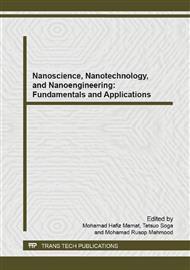p.564
p.568
p.572
p.577
p.582
p.587
p.593
p.598
p.603
The Effect of Au-Seeded Thickness to the Morphology of ZnO Nanostructures Obtained by Mist-Atomization on Heated Substrates
Abstract:
ZnO nanostructures were obtained by mist-atomisation technique. Nanostructured ZnO can be grown in aqueous solution of zinc nitrate hexahydrate as precursor solution with the addition of stabilizer hexamethylenetetramine (HMTA). ZnO nanostructures deposited by mist-atomisation, with applied heat from the glass substrates’ downside. Firstly, the glass substrates were seeded by Au with different thickness of 0 (non-seeded), 6, and 12 nanometer (nm). The growth of ZnO on different Au-seeded thickness is studied. The optical properties of ZnO nanostructures were examined by Ultraviolet-Visible (UV-Vis) spectroscopy. The morphology of the ZnO thin films obtained was studied by FESEM. FESEM micrographs shows different nanostructures formed on different thickness of Au-seeded glass. UV-vis spectra of ZnO nanostructures display high absorption in the UV region and high transparency in the visible region. There is improvement in UV absorption for ZnO growth on 6nm Au-seeded compared to non-seeded and 12 nm Au-seeded glass due to imperfect alignment of ZnO nanostructures.
Info:
Periodical:
Pages:
582-586
Citation:
Online since:
June 2015
Keywords:
Price:
Сopyright:
© 2015 Trans Tech Publications Ltd. All Rights Reserved
Share:
Citation:


